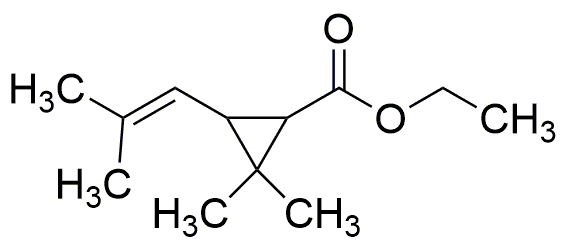Ethyl 2,2-dimethyl-3-(2-methyl-1-propenyl)cyclopropane-1-carboxylate is widely utilized in research focused on:
- Flavor and Fragrance Industry: This compound is used in the formulation of flavors and fragrances due to its pleasant aroma, enhancing products like perfumes and food flavorings.
- Agricultural Applications: It serves as an intermediate in the synthesis of agrochemicals, contributing to the development of effective pesticides and herbicides that improve crop yields.
- Pharmaceutical Development: The compound is explored for its potential in drug synthesis, particularly in creating new therapeutic agents that target specific health conditions.
- Polymer Chemistry: It is employed in the production of specialty polymers, offering unique properties that can enhance material performance in various applications.
- Research and Development: This chemical is a valuable tool in academic and industrial research settings, facilitating studies in organic synthesis and reaction mechanisms.
General Information
Properties
Safety and Regulations
Applications
Ethyl 2,2-dimethyl-3-(2-methyl-1-propenyl)cyclopropane-1-carboxylate is widely utilized in research focused on:
- Flavor and Fragrance Industry: This compound is used in the formulation of flavors and fragrances due to its pleasant aroma, enhancing products like perfumes and food flavorings.
- Agricultural Applications: It serves as an intermediate in the synthesis of agrochemicals, contributing to the development of effective pesticides and herbicides that improve crop yields.
- Pharmaceutical Development: The compound is explored for its potential in drug synthesis, particularly in creating new therapeutic agents that target specific health conditions.
- Polymer Chemistry: It is employed in the production of specialty polymers, offering unique properties that can enhance material performance in various applications.
- Research and Development: This chemical is a valuable tool in academic and industrial research settings, facilitating studies in organic synthesis and reaction mechanisms.
Documents
Safety Data Sheets (SDS)
The SDS provides comprehensive safety information on handling, storage, and disposal of the product.
Product Specification (PS)
The PS provides a comprehensive breakdown of the product’s properties, including chemical composition, physical state, purity, and storage requirements. It also details acceptable quality ranges and the product's intended applications.
Certificates of Analysis (COA)
Search for Certificates of Analysis (COA) by entering the products Lot Number. Lot and Batch Numbers can be found on a product’s label following the words ‘Lot’ or ‘Batch’.
*Catalog Number
*Lot Number
Certificates Of Origin (COO)
This COO confirms the country where the product was manufactured, and also details the materials and components used in it and whether it is derived from natural, synthetic, or other specific sources. This certificate may be required for customs, trade, and regulatory compliance.
*Catalog Number
*Lot Number
Safety Data Sheets (SDS)
The SDS provides comprehensive safety information on handling, storage, and disposal of the product.
DownloadProduct Specification (PS)
The PS provides a comprehensive breakdown of the product’s properties, including chemical composition, physical state, purity, and storage requirements. It also details acceptable quality ranges and the product's intended applications.
DownloadCertificates of Analysis (COA)
Search for Certificates of Analysis (COA) by entering the products Lot Number. Lot and Batch Numbers can be found on a product’s label following the words ‘Lot’ or ‘Batch’.
*Catalog Number
*Lot Number
Certificates Of Origin (COO)
This COO confirms the country where the product was manufactured, and also details the materials and components used in it and whether it is derived from natural, synthetic, or other specific sources. This certificate may be required for customs, trade, and regulatory compliance.

